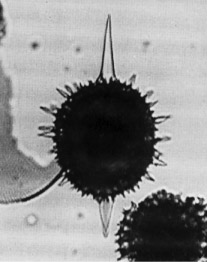 Stylatractus
universus Hays
Stylatractus
universus Hays[= Axoprunum angelinum (Campbell and Clark)]
 Stylatractus
universus Hays
Stylatractus
universus HaysStylatractus sp. Hays, 1965, p.167, pl.1, fig.6
Stylatractus universus Hays, 1970, p.215, pl.1, figs.1-2
Skeleton consists of 1 cortical and 2 medullary shells, medullary shells spherical, cortical shell prolate. Innermost shell thin-walled, pores circular with hexagonal borders. Second shell thin-walled, pores regular to irregular in size and shape. Cortical shell wall very thick. Pores circular to oval, 11-14 across equatorial diameter, surface varying from smooth to rough. Medullary shells connected to cortical shell by numerous stout radial beams, two lying along the major axis project through cortical shell as stout polar spines; other beams radiate out in all directions from bases attached to inner medullary shell. Some beams penetrate through cortical shell and form short primary spines. Shell bears two large, nearly equal, polar spines as long to half as long as major axis of cortical shell (Hays, 1965).
Diameter of innermost shell 15-20 µm, of 2nd shell 40-50 µm, of cortical shell (minor axis) 106-115 µm (major axis) 109-123 µm, length of spines 40-120 µm (Hays, 1965).
S. universus is distinguished from Stylacontarium acquilonium (Hays) (Kling, 1973, p.634. pl.1, figs.17-20, pl.14, figs.1-4) by its smaller size and smaller pores and the presence of two medullary shells.
There is an unnamed, sometimes co-occurring actinommid, which is very similar to S. universus in shell surface and pore size, but which is somewhat larger (cortical shell 120-140 µm) and has a spherical cortical shell, and no medullary shell (Sanfilippo et al., 1985).
A prolate cortical shell, containing two spherical medullary shells, bears stout polar spines, which are circular in cross section and nearly as long as the major axis of the cortical shell (100-125 µm). The only substantial morphological variation is in the beams (not restricted to the equatorial plane), which connect the cortical and medullary shells. In some cases these project through the cortical shell as short spines in addition to the two, longer polar spines (Sanfilippo et al., 1985).
S. universus is practically cosmopolitan. In middle Quaternary sediments, its upper limit constituting an important stratigraphic datum in the middle of the Brunhes magnetic epoch. The lower limit of its range is not known, but may be as old as Paleocene. Its morphotypic last appearance lies within the Collosphaera tuberosa Zone.
In the tropical Indian Ocean, Johnson et al. (1989) used the upper limit of Stylatractus universus to divide the Collosphaera tuberosa Zone into two zones.
There is a difficult and convoluted problem as to whether this form should be called Stylatractus universus Hays or Axoprunum angelinum (Campbell and Clark) (see Nigrini and Lombari, 1984). Usage seems to favor S. universus. The taxonomy of A. angelinum can be found in Kling, 1973, p.634.
Additional illustrations can be found in Kling, 1971, pl.1, figs.7 and Kling, 1973, pl.1, figs.13-16, pl.6, figs.14-18.